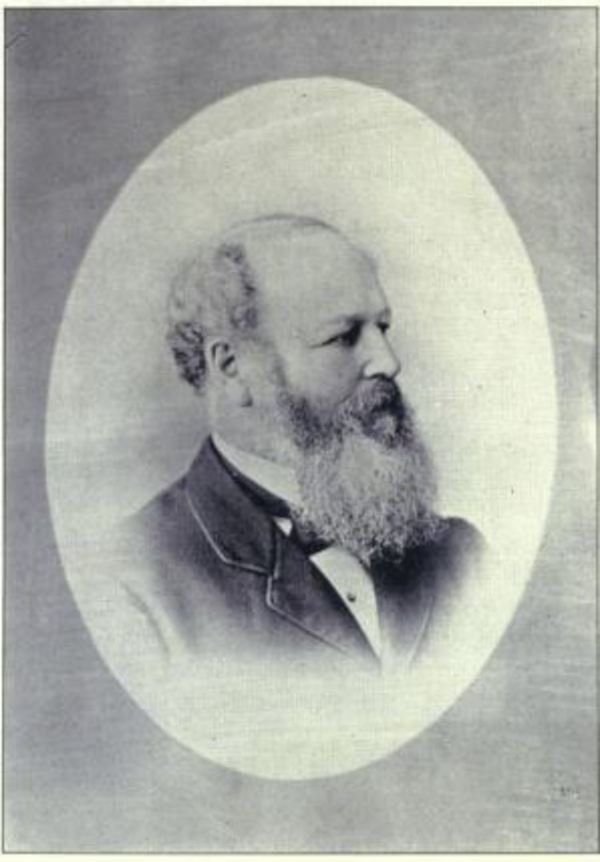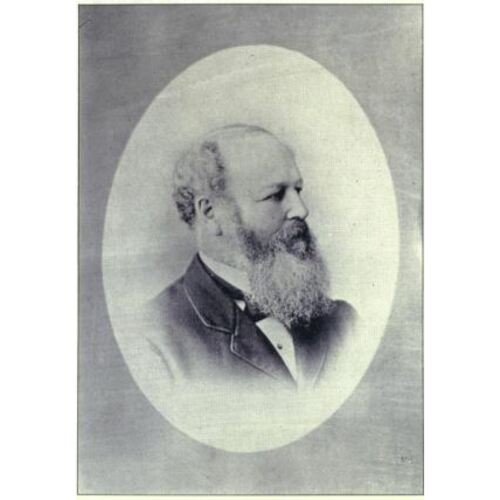As part of the funding agreement between the Dictionary of Canadian Biography and the Canadian Museum of History, we invite readers to take part in a short survey.

Source: Link
SMITH, ALEXANDER MORTIMER, soldier, businessman, militia officer, and politician; b. 8 May 1818 in Monymusk, Scotland; m. Mary Ann Barnes; d. 19 Jan. 1895 in Toronto.
Alexander Mortimer Smith was born in a rural parish in Aberdeenshire. As the son of a poor man, he had limited opportunities, and after receiving a basic education he eagerly embraced a career in the military. In 1836 he enlisted in the 93rd Foot, like many young men in his native county. By November 1838 the regiment had reached Toronto, where for six years it would maintain, in the words of one inspecting officer, “its character for comparative sobriety and good order amidst the dissipation with which it appears to be surrounded.”
Listening to the pleas of friends and family rather than the offer of a commission from his commanding officer, Smith left the regiment in 1840 to enter commerce. He soon found work with a grocery merchant, and his industry and sound business sense brought about a quick improvement in his position. By 1846 he was operating his own general store on Queen Street, and over the next decade his operations moved south, closer to the mercantile heart of the city, where he expanded into two stores and dealt in retail groceries and crockery. In partnership with John Smith* (no relation) he ventured into the wholesale grocery trade in the late 1850s, and at roughly the same time became briefly involved in selling lumber, a business that was then growing rapidly in Toronto.
Success in his commercial endeavours soon brought Smith considerable security and reputation. In 1855 he had been solicited by a number of influential citizens to run for the city council, and after his election he served for a year as a councillor. In 1858 he was elected alderman for St James’ Ward, with Oliver Mowat*. Smith was returned in 1859, but by February he had submitted his resignation. Although his reasons are not clear, later descriptions indicate that he could be difficult to work with and was not the stuff of which politicians are made. Nevertheless, the respect of Smith’s peers for his hard work on many of the most important committees was reflected in their reluctance to accept his retirement.
Smith’s rising prominence had also been marked by his rejuvenated military career. As one contemporary noted, Smith was a “born soldier,” and in 1856 he was offered the command of a Highland rifle company formed in response to the Militia Act of 1855. Three years later the unit amalgamated with five other volunteer companies to form a battalion eventually known as the Queen’s Own Rifles. Smith received his majority on 26 April 1860, but in November 1865 he waived his claim to command the battalion, presumably because of the pressures of public office. After briefly commanding a provisional battalion, he resigned on 13 July 1866. He would never lose his keen interest in military affairs. Nor did he lose interest in things Scottish. Along with other officers of his company, in September 1858 Smith had participated in the formation of the Caledonian Society for the encouragement of Scottish arts and athletics. He also belonged to the benevolent St Andrew’s Society, serving as its president in 1866 and 1867.
The clearest expression of Smith’s priorities, however, was his involvement with the Toronto Board of Trade. He joined in 1856, served as president in 1877, and was consistently elected to the council. His appointments reflected the extent to which his ideas mirrored those of the members, the majority of whom were foreign-born wholesalers. The board was a staunch supporter of projects designed to enhance Toronto’s economic domination of its hinterland, and Smith was a leading proponent of one such scheme, the Toronto and Nipissing Railway. Although it failed financially (it would be absorbed into the Midland Railway in 1882), this and similar narrow-gauge railways gave added security to wholesalers by providing more direct access to markets, thereby eliminating the need for jobbers and middlemen. Very aware of the fragility of the province’s economic framework after the depression of 1857–58, the board was also anxious to develop more sophisticated financial institutions. Smith typified this diversification of interests by his election during the 1860s to the boards of the Provincial Mutual and General Insurance Company, the Western Assurance Company, the Canada Permanent Building and Savings Society, and the Canadian Bank of Commerce. He was also president of the Royal Canadian Bank, where he experienced a brush with scandal in 1869 after cries of mismanagement were raised by Senator Donald McDonald*.
The Board of Trade often articulated its concerns through provincial politics, and the election of 1863 gave Smith an opportunity to voice many of these issues on the hustings. Nominated as the Reform party’s candidate for Toronto East when George Brown* refused to stand, Smith ran on a platform which embraced not only the usual party policies but also a number of proposals designed to enhance the economic position of Toronto and its merchants. Although he was attacked by James Beaty’s Leader as “a man of mediocre acquirements and talents,” unable to “speak a half-dozen sentences respectably,” the criticisms could not deflect attention from the support expressed for the government’s Separate School Bill by the incumbent, John Willoughby Crawford*. Led by Alderman Francis Henry Medcalf*, a Conservative, the Orange vote that had elected Crawford three years earlier went to Smith. His substantial majority and John Macdonald*’s victory over John Beverley Robinson in Toronto West gave the Reform party unprecedented success in the city.
Smith’s term in the Legislative Assembly gave some credence to Beaty’s opinions, for he seldom spoke, save for brief comments on commercial and militia matters. Nevertheless, he would probably have been renominated for the federal election of 1867 had it not been for his support in the assembly for the Taché–Macdonald coalition government. In spite of his election upon the Reform slate, he vowed at the nomination meeting in August 1867 never to “offer a continual, factious opposition to any Government” should it lead to the defeat of reasonable measures, and he challenged anyone to win Toronto East without Conservative support. Such talk of independence led to a vociferous attack by George Brown and Smith’s withdrawal from the contest on 23 Aug. 1867. His eventual successor, William Thomas Aikins, was soundly defeated by Beaty, the Conservative candidate.
Smith’s retirement from politics was interrupted by a campaign for the mayoralty in 1874. He was brought into the race by several leading citizens after it had been suggested that there was some impropriety in the relationship of the incumbent, Alexander Henderson Manning*, with contractors employed to construct Toronto’s waterworks. Smith’s campaign was plagued by aspersions on his conduct in 1867, and many of the city’s leading Reformers supported a late candidate, Francis Medcalf. It was ironic that Smith’s final foray into politics should end in defeat at the hands of the man responsible for his victory in 1863.
Around 1871 Smith formed a partnership with William Walker Keighley, who had been manager in Toronto for Reford and Dillon, importers and wholesale grocers. Smith and Keighley was the successor to this Montreal-based operation, and the firm grew into one of the major wholesale outlets in Toronto. With other interests in Toronto and Owen Sound it organized the Canada Lake Superior Transit Company in 1880. This company was established to carry on a forwarding business on the Upper Lakes, but by the 1890s its steamers were bound for American ports such as Rochester, N.Y. Because of his interest in shipping, Smith was a frequent choice as one of the Board of Trade’s representatives on the Harbour Trust, and he petitioned his former parliamentary colleagues for federal funds to improve the western entrance to Toronto Harbour.
Although a severe bout of influenza in 1891 slowed him down, Smith remained involved with a number of financial institutions, serving as vice-president of the Ontario Bank and president of the Western Assurance Company. Early in 1894 his health began to deteriorate, and he died a year later. His will left large sums of money to family members and to a number of charities such as the Hospital for Sick Children, on whose board he had sat. It revealed a man who, through industry and the judicious diversification of financial interests, had risen from modest beginnings to achieve prosperity and considerable respect from his peers. Although he did not share all their talents, his breadth of interests and involvement in military, commercial, and public affairs mark him as an exemplar of his contemporaries.
AO, MU 307. CTA, RG 1, A, 1855–59. NA, MG 28, III 56, 3 (mfm. at MTRL). Toronto Harbour Commission Arch., RG 1/1/1, vol.1; RG 1/4, box 4, vol.1; RG 2/1, box 1, vol.2; SC 26, box 6, vol.3. York County Surrogate Court (Toronto), no.10726 (mfm. at AO). Can., Prov. of, Legislative Assembly, App. to the journals, 1857–59; Journals, 1863–67. Canada Gazette, 14 (1880): 267. “Parliamentary debates” (Canadian Library Assoc. microfilm of the debates of the legislature of the Prov. of Canada and the parliament of Canada, 1846–74), 1863–67. Evening Telegram (Toronto), 19 Jan. 1895. Globe, 1856–95. Leader (Toronto), 1863–67. Mail (Toronto), December 1873–January 1874. Monetary Times, 1870–78. Toronto Evening Star, 19–21 Jan. 1895. Toronto directory, 1843–95. G. M. Adam, Toronto, old and new: a memorial volume . . . (Toronto, 1891). E. J. Chambers, The Queen’s Own Rifles of Canada . . . (Toronto, 1901). Robertson’s landmarks of Toronto, vo1.2. Toronto, Board of Trade, “A souvenir”.
Cite This Article
Michael B. Moir, “SMITH, ALEXANDER MORTIMER,” in Dictionary of Canadian Biography, vol. 12, University of Toronto/Université Laval, 2003–, accessed March 29, 2025, https://www.biographi.ca/en/bio/smith_alexander_mortimer_12E.html.
The citation above shows the format for footnotes and endnotes according to the Chicago manual of style (16th edition). Information to be used in other citation formats:
| Permalink: | https://www.biographi.ca/en/bio/smith_alexander_mortimer_12E.html |
| Author of Article: | Michael B. Moir |
| Title of Article: | SMITH, ALEXANDER MORTIMER |
| Publication Name: | Dictionary of Canadian Biography, vol. 12 |
| Publisher: | University of Toronto/Université Laval |
| Year of revision: | 1990 |
| Access Date: | March 29, 2025 |



